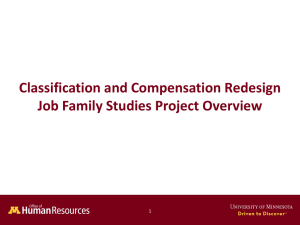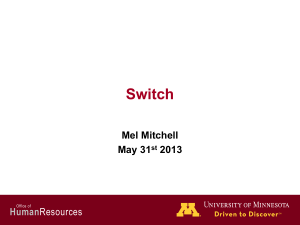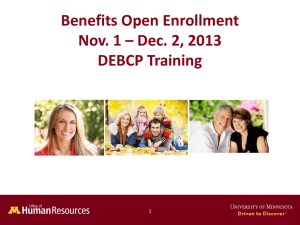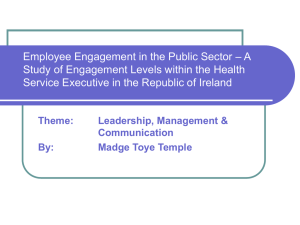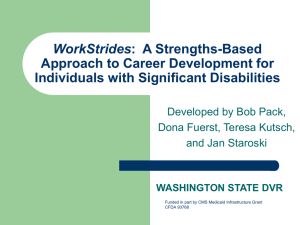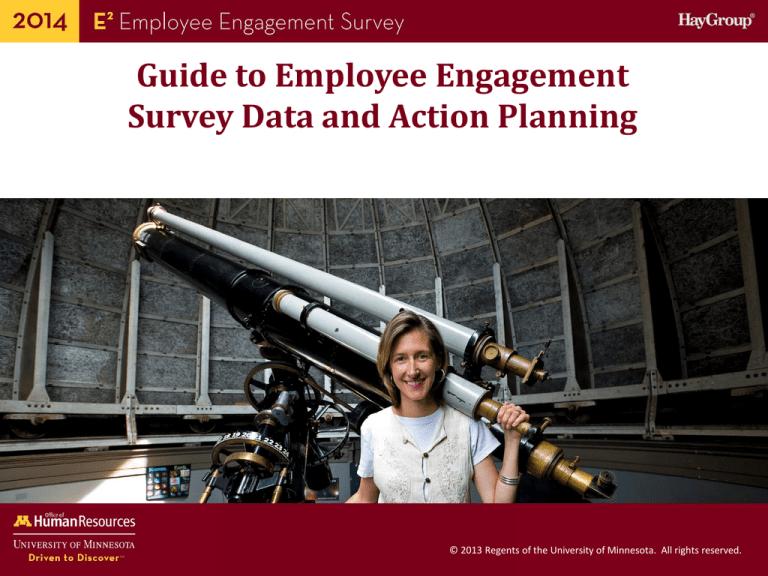
Guide to Employee Engagement
Survey Data and Action Planning
HumanResources
Office of
© 2013 Regents of the University of Minnesota. All rights reserved.
NOTE: This is a large document with information to
better understand 2014 E2 Employee Engagement
Survey data and how to take action.
Parts of the deck can be adapted and used to share
survey data.
This Guide is available online at Insight2Action (The Hay Group’s
online tool) or the OHR E2 website. (umn.edu/ohr/training/e2)
More information and talking points are in the notes section.
HumanResources
Office of
© 2013 Regents of the University of Minnesota. All rights reserved.
Guide Overview
•
•
•
•
•
•
•
About employee engagement and E2
Survey Data
Additional Question Detail
Next Steps: Action Planning & Implementation
Action Planning Resources
How to Use Insight2Action (I2A)
Tips for Sharing Progress
HumanResources
Office of
3
What Engagement Research
and Experience Tell Us
•
•
What sets great organizations apart? Dedication and
commitment to collective excellence and wellbeing.
Why is this important to the University? The degree to
which employee engagement is present profoundly shapes
the quality of experiences and outcomes in the workplace.
• Recruiting, retaining, and developing top talent
• Employee resilience and wellbeing
• Collaboration and innovation
• Sustaining a high-level of performance
HumanResources
Office of
43
The University’s Engagement Strategy
• Goal: Support campuses, colleges, and departments/units
address local workplace factors that support engagement
and enable excellence in research, teaching, and service
• Developed: In consultation with deans, chancellors, vicepresidents, faculty and staff leaders, governance groups and
a faculty advisory committee
• Combines validated items from Hay Group and customized items
created by the E2 Faculty Advisory Committee
• Aligned with U of M published research on drivers of researchproductive facilities (Bland, Weber-Main, Lund, & Finstad, 2005)
HumanResources
Office of
52
Survey Administration Summary
When
October 13 – 31, 2014
What
Separate faculty and staff surveys
How
Participation
HumanResources
36 scored questions in each survey
Assess commitment and dedication plus effective environment
Externally managed by Hay Group to ensure confidentiality
All benefits-eligible University of Minnesota faculty and staff
•
2,493 faculty responses (52% participation rate)
•
9,599 staff responses (68% participation rate)
Office of
6
Engagement Process and Timeline
Survey
(October)
Action Plan
HumanResources
Measure &
Share Progress
Review &
Share Results
(March–September)
(January –March)
Implement
Action Plans
Refine
Action Plans
(April–January)
(February –April)
Office of
7
Employee Engagement Model
HumanResources
Office of
8
The Three Most Important Things to Know
About Employee Engagement
1. A survey alone does not create positive change.
Only involving leaders, faculty, and staff in responding to survey
results can create positive change in the work environment.
2. Share your results. Disengagement begins when people who
take time to respond to a survey don’t hear their results from
their leaders.
3. Take action. A few small, simple actions can have a large
impact. Be certain to let faculty and staff know when actions were
taken based on their survey feedback.
HumanResources
Office of
9
How to Understand Your Report
• This report presents survey results for your work group.
• The survey measures employees’ levels of engagement
through the key metrics of commitment & dedication and
effective environment. The survey also looks at ten other
drivers of employee engagement.
• This guide has general guidelines. However, leaders need to
use their understanding of their employees to verify the
data against the context of their local environment.
HumanResources
Office of
10
How to Understand Your Report, cont’d
• The report is divided into four sections:
• Dimension and Engagement Results
• Strengths and Opportunities
• Additional Question Detail
• Next Steps
HumanResources
Office of
11
Review Survey Results Using
Multiple Lenses
Absolute
Scores
Survey Data
HumanResources
Office of
Comparisons
With
Benchmarks
Strengths and
Opportunities
Qualitative
Information
Context-Based Data
Survey Scales & Benchmarks
Benchmarks
Percentage Favorable Scale
• Favorable: “Strongly Agree” + “Agree” and “Very Good” + “Good”
• Neutral : “Neither Agree nor Disagree”
• Unfavorable: “Strongly Disagree” + “Disagree” and “Very Poor” + “Poor”
Percentage Favorable Difference Scale
Comparison to benchmarks are expressed as percentage-point differences in
percentage favorable scores for the same year (2014):
• “+” shows that your score is above the benchmark
• “-” shows your score falls below the benchmark
• Dashes (“—”) show a comparison is not possible
HumanResources
Office of
13
• 2014 Total University: results
across all campuses
• 2014 Total Campus: results for
your campus only
• 2014 Total College/Unit: results
for your college/unit or
department only
• 2013 Same Unit Results: Results
from your college/unit or
department in 2013
Understanding Your Results
• Review the percentage favorable bar chart
using this quick guide to help assess and
prioritize action.
• Consider the size of the group (“Valid N”
column) in terms of the practical significance
of the percentage favorable differences.
• Compare the proportion of neutral and
unfavorable responses for more insight:
•
•
A higher proportion of “neutral” than “unfavorable”
can be an opportunity to shift employee opinion
A higher percentage of “unfavorable” than “neutral”
may indicate action is needed
The question
number from
the survey
HumanResources
Office of
14
Quick Guide to Percent Favorable
Assessment
Range
Strength
>70% Favorable
Gather more
information
<60 % Favorable
Action likely
needed
>20% Unfavorable
Absolute Scores
• These focus on the percentage of faculty or staff
responding favorably, unfavorably, or in a neutral way
• Here are some broad guidelines when reviewing survey
results on an “absolute” basis
Quick Guide to Percent Favorable Absolute Scores
Assessment
Range
Strength
>70% Favorable
Gather more information
<60 % Favorable
Action likely needed
>20% Unfavorable
HumanResources
Office of
15
Absolute Scores, cont’d
• Be sure to look at the complete distribution of responses
• Scenario A—half Favorable with a large percentage of the rest
being Unfavorable
• Scenario B—One-half of respondents are Favorable with most of
the remaining being Neutral
HumanResources
Office of
16
Understanding Your Results, cont’d
• Results include percentage of favorable responses compared to unit-specific
2013 data (when available), as well as 2014 total campus and University
benchmark data.
• Percentage favorable differences between 2013 and 2014 are unit-specific and
may indicate areas of change in a more favorable or unfavorable direction.
• Use the quick guide (right) to
Quick Guide to Percent
assess the range of change
Favorable Difference
between 2013 and 2014.
Likelihood of
Meaningful Change
% Favorable Difference
2013 Same
Unit Results
2014 Total
University
+1
-1
+1
+1
+3
+1
HumanResources
2014 Total 2014 Total
Campus College/Unit
+1
+2
+1
+3
+8
+14
Office of
17
Range
Low
<5 percentage points above (+) or
below (-) the 2013 data
Medium
>5–10 percentage points above
(+) or below (-) the 2013 data
High
>10 percentage points above (+) or
below (-) the 2013 data
Qualitative Information
• The qualitative lens can provide more detailed
information about why items or dimensions
received particularly high or low scores. Consider:
• Are there other sources of information that contextualize the key
messages in the survey data?
• Are there ways to verify the key messages in the survey data
against other existing performance measures or metrics?
HumanResources
Office of
18
Survey Data
HumanResources
Office of
19
Summary of Engagement:
Key Drivers and Metrics
This slide can be
replaced with the
actual report slide
HumanResources
Office of
20
Results for Key Metrics:
Commitment and Dedication
Focus: Motivating employee dedication and commitment to
excellence.
Consists of results from the following survey questions:
This slide can be
replaced with the
actual report slide
HumanResources
Office of
21
Results for Key Metric:
Effective Environment
Focus: Supporting employees’ success with the tools and resources of an effective work
environment. Consists of results from the following survey questions.
This slide can be
replaced with the
actual report slide
HumanResources
Office of
22
Employee Engagement Profile
This slide can be
replaced with the
actual report slide
HumanResources
Office of
Strengths and Opportunities
• How strengths and opportunities are determined:
• Key factors are considered in identifying your work
group’s distinctive strengths and opportunities
including: absolute scores on the survey items
(percent favorable and unfavorable) and how your
work group’s scores compare to internal benchmarks
(Total University, Total Campus, and Total College).
HumanResources
Office of
24
Strengths and Opportunities, cont’d
• It is best to leverage strengths and identify areas
for action:
• While the opportunities present clear areas for
action planning, it’s also important not to lose
traction in those areas in which your group excels in
order to maintain and build upon your group’s key
strengths.
HumanResources
Office of
25
Key Strengths
Key strengths identify areas in which your work group is currently
most successful.
This slide can be
replaced with the
actual report slide
HumanResources
Office of
26
Key Opportunities
Key opportunities point to areas offering the greatest room for
improvement.
This slide can be
replaced with the
actual report slide
HumanResources
Office of
27
Additional Question Detail:
Commitment and Dedication Dimensions
HumanResources
Office of
28
Key Metric: Commitment and Dedication
Clear and Promising Direction
Focus: Connecting employees to college/unit strategy and goals
This slide can be
replaced with the
actual report slide
HumanResources
Office of
29
Key Metric: Commitment and Dedication
Commitment to Excellence
Focus: Encouraging high quality education, research, and
services
This slide can be
replaced with the
actual report slide
HumanResources
Office of
30
Key Metric: Commitment and Dedication
Confidence in Leaders
Focus: Inspiring trust through open communications and
leadership support
This slide can be
replaced with the
actual report slide
HumanResources
Office of
31
Key Metric: Commitment and Dedication
Development Opportunities
Focus: Supporting employees in developing and achieving
career objectives
This slide can be
replaced with the
actual report slide
HumanResources
Office of
32
Key Metric: Commitment and Dedication
Respect & Recognition
Focus: Valuing employees and acknowledging their
contributions
This slide can be
replaced with the
actual report slide
HumanResources
Office of
33
Additional Question Detail:
Effective Environment Dimensions
HumanResources
Office of
34
Key Metric: Effective Environment
Authority & Empowerment
Focus: Encouraging employee autonomy and innovation to
improve work
This slide can be
replaced with the
actual report slide
HumanResources
Office of
35
Key Metric: Effective Environment
Clear Expectations and Feedback
Focus: Clarifying performance expectations and providing
regular feedback
This slide can be
replaced with the
actual report slide
HumanResources
Office of
36
Key Metric: Effective Environment
Collaboration
Focus: Supporting cooperation and sharing of ideas within and
across work groups
This slide can be
replaced with the
actual report slide
HumanResources
Office of
37
Key Metric: Effective Environment
Support and Resources
Focus: Ensuring that employees have the skills, information and
resources to do their job well
This slide can be
replaced with the
actual report slide
HumanResources
Office of
38
Key Metric: Effective Environment
Work, Structure, & Process
Focus: Promoting innovation and equitable distribution of
workload
This slide can be
replaced with the
actual report slide
HumanResources
Office of
39
Next Steps: Action Planning
and Implementation
HumanResources
Office of
40
Action Planning Overview
• Action Planning Principles and
Processes
• Engagement key next steps
• Prioritizing opportunities with data
interpretation and understanding
common reactions
• Action items, tools and resources
• Documenting and tracking action plans
• Sample action plans
• Sharing results
HumanResources
Office of
41
Action Planning Principles
• Fully understand the results and underlying issues.
Gather additional information until the context is clear or
root causes are identified.
• Involve faculty and staff where appropriate. Faculty
and staff can help leaders understand the underlying
issues and opportunities and find appropriate solutions.
• Keep it simple by concentrating on one or two issue areas
instead of tackling too many areas at once.
HumanResources
Office of
42
Action Planning Principles, cont’d
• Focus on issues within your control. Spend time on
those areas where you can have the most impact.
• Provide regular updates on progress. Ensure that
faculty and staff know that changes are being made based
on their survey feedback.
HumanResources
Office of
43
Action Planning Principles, cont’d
• The most effective action plans are:
• Clear and specific
• Link to unit objectives
• Focus on a manageable number of action priorities
(1-3)
• Focus on action areas that can have an impact
• Clearly assign accountability
• Existing action plans will only need to be
refined to ensure they are relevant.
HumanResources
Office of
44
Action Planning Process
Identify
the Issues
Analyze survey results
Understand
Context
Build Detailed
Action Plan
Implement
the Plan
Collect faculty/staff
feedback through team
meetings, focus groups
Use Hay Group’s online
action planning tool
Track progress on a
regular basis
(Insight2Action)
(monthly or quarterly)
Criteria for selecting issues:
Insights to gather:
Important considerations:
Key success factors:
•
• Driving force(s) behind
the issues identified
• Specific actions to be
taken
• Groups affected by the
issues (e.g., job level,
tenure)
• Resources and support
needed
• Ongoing support of
those implementing
action plans
The issue is widespread
and/or is having a
significant impact
•
Leadership has the ability
to improve the issue
•
Improvement will likely
result in more engaged
faculty and staff
•
Each issue is aligned with
the college/unit’s mission
and goals
HumanResources
Office of
• Assignment of
accountabilities
• Tracking of progress
on implementation
over time
• Clear measures of
success
• Sharing progress
regularly
Engagement Key Next Steps
Review &
Share Results
All Leaders
•
•
•
Local HR
Leads and
HR Staff
•
•
January–March
Share results with the
unit/department; lead
discussion of results to
further understand possible
areas for action
Share data with next-level
leader if no report is
available.
Set expectations that all
leaders share results with
the unit/department
including roll-up data
Provide consultation on
individual leader report data
when requested
Provide context for data with
key issues, goals, and
initiatives as needed
HumanResources
Refine
Action Plans
•
•
February–April
Share and refine current
plans; if a plan does not
exist, lead creation of an
action plan for 1–2 actions
to improve engagement
Set expectations that all
leaders take 1–2 actions to
improve engagement
Implement
Action Plans
•
•
April–January
Ensure that meaningful
actions are taken and
communicated
Hold all leaders accountable
for taking action and
incorporate engagement in
goal setting
Measure &
Share Progress
•
•
•
•
Provide guidance where
needed for individual
leaders on action planning
Office of
46
•
Support leaders as requested
with action planning and
communicating progress
•
March–September
Comparison on “percent
favorable survey
responses” for metrics
and key drivers from
2013 (when available)
to 2014
Communicate and
celebrate progress
to-date
Encourage 2015 survey
participation
Implement local
communications plan
for 2015 survey
participation
Engagement Key Next Steps, cont’d
Review &
Share Results
Employee
Relations
Consultants
•
•
Leadership &
Talent
Development
Consultants
•
January–March
Provide consultation on
data in executive report
in collaboration with HR
Lead
Consult as needed on
data in the context of key
issues, goals, and
initiatives
Create and roll out
reports, deliver executive
presentations and
provide action-planning
tools and resources
Refine
Action Plans
•
•
•
•
HumanResources
Implement
Action Plans
February–April
Support units with HR Leads
in developing Communities
of Practice locally, with
groups of leaders such as
faculty groups, department
chairs, and administrators
•
•
April–January
Support HR Leads in
executive-level action
planning
Advise HR Leads as needed
on local Communities of
Practice
Conduct additional data analysis; provide information and
guidance for using reports to better understand the data and
inform action-planning
Provide consultation as requested to senior leaders and OHR
leads and Employee Relations Consultants
Identify enhancements/changes to the survey process for fall of
2015
Office of
47
Measure &
Share Progress
•
•
March–September
Provide units with
communications to
support 2015 survey
participation
Implement system-wide
2015 survey promotion
and administration
Key Accountabilities in Next Steps
Everyone has a role to play in the action planning process
Key accountabilities
•
Communicate results; create and implement action plans in partnership with local HR as
needed
•
Support managers and supervisors within span of control in also taking action
•
Involve faculty and staff in the process and keep them well informed
•
Monitor action planning efforts and hold managers accountable for taking action
Faculty
and Staff
•
Provide input into the action planning process including more detail around results
•
Participate in the implementation of action plans
Human
Resources
•
OHR consultation and collaboration are supporting local HR efforts
•
Share best practices and identify common issues and solutions
•
Assist units in action planning to support engagement as requested
All leaders
HumanResources
Office of
Data Interpretation Considerations
• Are there key strengths or opportunities that catch your attention?
• Which of the 10 dimensions should get your focus and why?
• What survey item may be an additional area of focus or action planning?
• Consider the following in addition to the data:
• Consider qualitative data to deepen and connect the survey data
• Your expectations based on your experience and knowledge
• What steps would you recommend to gather further information and
how might you go about this?
HumanResources
Office of
49
Range of Leader Reactions to Results
Be aware of your response
to the data and seek to
work with others to find
solutions.
Leaders can unintentionally
derail engagement through
their own reactions to the
data.
• Shock—“How can faculty/staff have
the audacity to respond this way?”
• Anger—“We’ve spent a lot of time on
this but no one sees it?”
• Resistance—“This can’t be! The
data is invalid.”
• Acceptance—“OK...we really
might have to address this.”
• Help—“What can we do to change?”
HumanResources
Office of
50
Personal Power—What can I do?
• Ask your supervisor, manager, or leaders about
your group’s survey results.
• Offer to participate in action planning (focus
groups, employee-led workgroups, etc.)
• Support taking action on engagement survey
results to foster a positive culture.
• Check out the engagement web page resources.
• Ask leadership about action plans.
• Give your feedback in the next survey.
HumanResources
Office of
Action Planning Resources
HumanResources
Office of
52
Helpful Tools & Resources
Review &
Share Results
•
TechnologyBased Support
for All Leaders
•
January–March
Insight2Action (I2A)
website (Hay Group)*
“Interpreting your
Engagement Survey
Report Quick Course”
(ULearn) and
customizable PowerPoint
Refine
Action Plans
•
•
February–April
Insight2Action (I2A) website
(Hay Group)*
E2 website action ideas and
resource library
(www.umn.edu/ohr/training/e2/con
sulting/index.html)
Implement
Action Plans
•
•
•
April–January
Insight2Action (I2A)
website (Hay Group)*
Track action plan
implementation on the
I2A website (optional)
E2 website action ideas
and resource library
Measure &
Share Progress
•
•
(www.umn.edu/ohr/training/e2
/consulting/index.html)
March–September
Comparison on “percent
favorable survey
responses” for metrics
and key drivers from
2013 when available to
2014
Communications Toolkit
on the E2 website
•
All University
of Minnesota
Employees
•
Engage in survey data
sharing and ask your
supervisor about your
unit/team report
•
Engage in action planning
with support of E2 website
action ideas and resource
library
(www.umn.edu/ohr/training
/e2/consulting/index.html)
•
Support action plan
implementation with
resources on the E2
website action ideas and
resource library
•
Inquire about progress
on action planning and
stay up-to-date on
employee engagement
communications
(www.umn.edu/ohr/training/e2
/consulting/index.html)
*Leaders will receive a report, and access to the Insight2Action website, if they have 10 faculty or 10 staff members who completed the 2014
surveys.
HumanResources
Office of
53
How to Use Insight2Action (I2A) to Document
Actions and Track Progress
HumanResources
Office of
54
Insight2Action Website
• Insight2Action website
HumanResources
Office of
55
Possible Faculty Action Plan
Development Opportunities
My department offers effective mentoring and coaching to support my development.
• Leader considerations: How can we leverage internal skills
to help mentor and coach faculty?
• Information to gather: How could mentoring and coaching
assist your professional development?
• Possible Action Plans: Support a faculty work group in
suggesting resources and a process for a pilot mentoring
program. Document results and adjust as needed.
HumanResources
Office of
56
Possible Staff Action Plan
Clear Expectations and Feedback
My manager/supervisor provides clear and regular feedback on how well I do my work.
• Leader considerations: How are performance expectations
communicated to staff? How clear and specific are these
expectations? How often are these discussions occurring?
• Information to gather: How do you ask leaders for feedback
and guidance on job performance, especially when you
encounter challenges?
• Possible Action Plans: Ensure performance goals define
criteria for minimum, acceptable, and superior performance.
Have solid feedback processes and monitor results.
HumanResources
Office of
57
Communicating and Sharing
Best Practices
• The top communication priority is to share results within
the college/unit
• Encourage leaders to document and track action plans in
the Hay Group’s I2A system or another system
• Encourage partnerships with local communications teams
to promote actions taken as a result of survey feedback
• Identify if a local Community of Practice would be helpful
to support action planning and best practices
HumanResources
Office of
58
Review: The Three Most Important Things
About Employee Engagement
1. A survey alone does not create positive change.
Only involving leaders, faculty, and staff in responding to survey
results can create positive change in the work environment.
2. Share your results. Disengagement begins when people who
take time to respond to a survey don’t hear their results from
their leaders.
3. Take action. A few small, simple actions can have a large impact.
Be certain to let faculty and staff know when actions were taken
based on their survey feedback.
HumanResources
Office of
59

